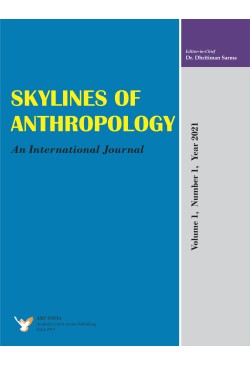
Skylines of Anthropology
Frequency :Bi-Annual
ISSN :2583-1402
Peer Reviewed Journal
Barman Tribes Culture and their Interactions with Forest Resources
Socio-economic and cultural practices are unique among the different ethnic groups, especially in the tribal community. The Barman tribes are one of the major tribal groups in Assam. Most prominently, they live as scheduled tribes in lower Assam and the Barak Valley. Dimasa Barman people are dispersed throughout the Cachar district, inhabiting in small groups in several villages. The Joynagar Forest village is one of the largest Barman living forest villages in the Cachar district. The Barman is distinct from the other ethnic groups in Assam’s forest settlement because of his own socioeconomic practices, cultural practices, and traditions. They engage in a variety of productive activities while living in the forest and rely on forest resources for their family’s survival and earnings. Additionally, they encounter a variety of life-threatening issues as a result of their way of life. The article primarily outlines the Barman culture and their interaction with forest resources among Barman tribes residing in a forest village, namely Joynagar forest village in Assam’s Cachar district. Furthermore, the study explores the socioeconomic factors, the cultural backdrop, and the features of the forest that support the life and family income of the tribe. For this study, authors have relied on primary sources and data has been collected from 50 respondents who are actively engaged in forest resources in Joynagar forest village with the help of an interview schedule. Apart from this, insights on cultural practices and forest resource uses were gathered through Focused Group Discussions (FGDs) with key individuals from the Joynagar forest community, including the Mother group, Youth Club, Bandhan Group, Anganwari worker, Helper, ANM, ASHA, Head Teacher, and Goan Bura. In light of this context, the article also discusses the implications for future research and practice.
Keywords: Barman tribe, culture, forest village, forest resources, socio-economic life.
The Sinaitic Covenant, Organized Religion and Nigeria’s Development
???????Keywords: Sinaitic covenant, religion, Nigeria, poverty, development, Love, Conflict
Factors Affecting Depression among the Juangs: A Vulnerable Tribal Group in Odisha
Panda, S.S., Kuiti, B.K., Sahoo, S., Chinara, M., & Patra P.K. 2022. Factors Affecting Depression among the Juangs: A Vulnerable Tribal Group in Odisha. Skylines of Anthropology, 2: 1, pp. 25-44.
A Constructed Sexuality: Re-Discovering the Jogappas of South and West India
Viewing Forgiveness through the Lens of Spirituality
Kaushik, A., Sinha, A., Govind & Sharma, A. 2022. Viewing Forgiveness through the Lens of Spirituality. Skylines of Anthropology, 2: 1, pp. 59-77.
Perceptions, Awareness and Knowledge about Type 1 Diabetes Mellitus
Exploring The ‘Self’: Ethnicity, Identity and Food
Zaman, R. 2022. Exploring the ‘Self’: Ethnicity, Identity and Food. Skylines of Anthropology, 2: 1, pp. 87-99.